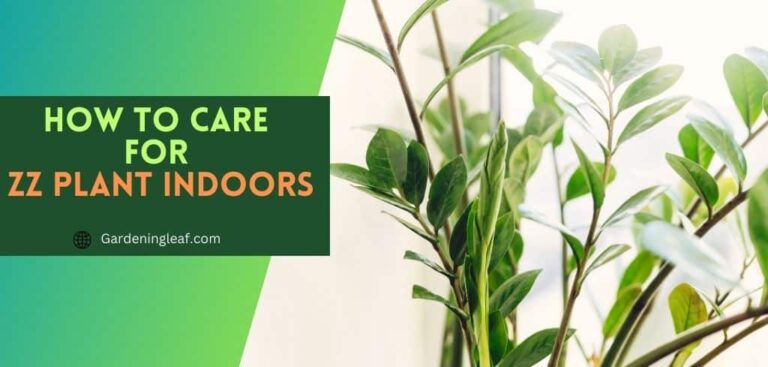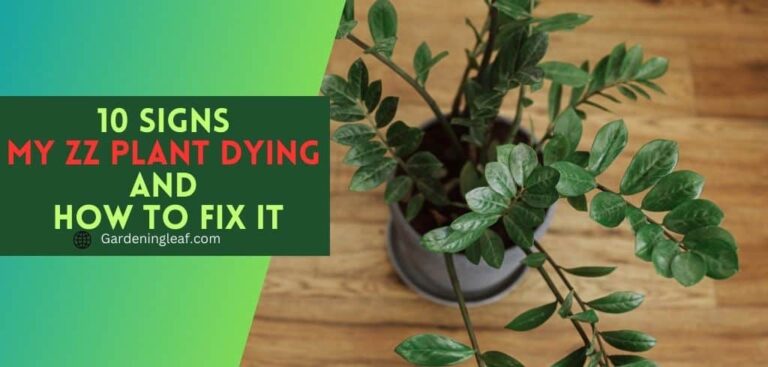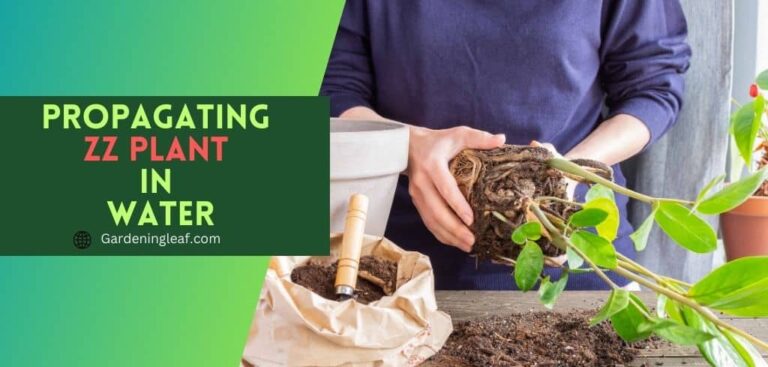Unlock the Mystery: 8 Possible Reasons Why Your ZZ Plant Refuses to Grow!
The ZZ plant is referred to as Zamioculcas zamiifolia. It is a popular houseplant loved for its unique foliage and easy care requirements. This tropical plant features glossy, dark green leaves. That grows in an attractive, upright manner, making it a great addition to any indoor space.

The ZZ plant is known for purifying the air by removing toxins such as benzene, toluene, and xylene. This low-maintenance plant requires minimal watering and can tolerate low-light conditions. That’s why it is ideal for those new to plant care or with limited space.
Despite being an easy plant to care for, some plant owners may notice that their ZZ plant is growing slower or more vigorously than it had hoped.
Here, we will discuss why is my zz plant not growing. And offer tips for promoting healthier and more robust growth.
So, if you’re a plant parent concerned about the growth of your ZZ plant, keep reading for some helpful insights and advice.
Common Reasons Why Is My ZZ Plant Not Growing?
If your ZZ plant not growing new leaves as it should be, several possible causes could exist. First, we need to find out possible reasons why is my ZZ plant not growing. We will discuss potential reasons behind a problem so you can identify it early and find a solution.
Read More:- Propagating ZZ Plant in Water: Easy Tips
Lack of proper lighting
One common reason why ZZ plants may not be growing is the Lack of proper lighting. However, although these plants may survive in low-light conditions, they still need sufficient light to grow and flourish.

ZZ plants prefer bright, indirect light, and they may not grow well if they get Full-day Direct sunlight. Direct sunlight for prolonged periods can scorch their leaves and slow their growth. But, They can tolerate 1-2 hours of direct sunlight in the early morning or late afternoon.
If your ZZ plant is not near a window or the light it receives is too dim, it may not grow. You might want to consider relocating your plant to a spot where it can get more natural light.
Also, the weather and season outside can impact the lighting and temperature. If your plant does not receive sufficient light, relocating can solve your problem.
Overwatering or Underwatering
Another potential culprit for stunted growth in ZZ plants is Overwatering or underwatering. These plants are adapted to survive in drought-prone environments.
So they do not need frequent watering. An overwatered plant is more likely to develop root rot, which can cause the plant to wilt and eventually die.
Check the soil regularly and only water when the top inch of the soil feels dry. If you suspect overwatering, allow the soil to dry out before watering again.
On the other hand, if you suspect underwatering, increase the watering frequency and ensure the plant is getting enough light. Your ZZ plant can thrive and grow fully with proper care.
Incorrect soil type
Your soil type can also affect how well your ZZ plant grows. These plants prefer well-draining potting soil that drains properly and does not retain extra moisture.
If your plant struggles to grow, it may be due to too heavy or dense soil. Consider repotting your ZZ plant with a well-draining soil mix and adding perlite or sand to improve drainage.
Pests and diseases
Pests Another potential reason for stunted growth in ZZ plants could be pests. Pests like mealybugs, scale insects, and spider mites can rob a plant of its nutrition and stop it from developing.
Check your ZZ plant regularly for insect indications like webs or sticky residue on the foliage. If you spot bugs, treat them promptly with a natural or chemical insecticide to avoid additional damage. You can use natural insecticides Like Mighty Mint Pest Control Peppermint Oil or Neem Oil.
Location
The location of your ZZ plant can also impact its growth. For optimal growth and health, these plants need bright, indirect light. And temperatures ranging between 65 and 75°F (18 and 24°C).
Harsh hot or cold conditions can harm the plant’s growth and health. Inadequate light or exposure to extreme temperatures may slow the plant’s growth and development.
So, provide suitable conditions to promote healthy growth and thriving of your plant. Consider moving your plant to a brighter spot that receives filtered sunlight. Or keeping it away from windows that get direct sunlight.
Also, keep away from drafts and air conditioning vents. It can cause temperature fluctuations that can harm the growth.
Read More:– How to Care for ZZ Plant Indoors: Effortless Care Guide
Rootbound:
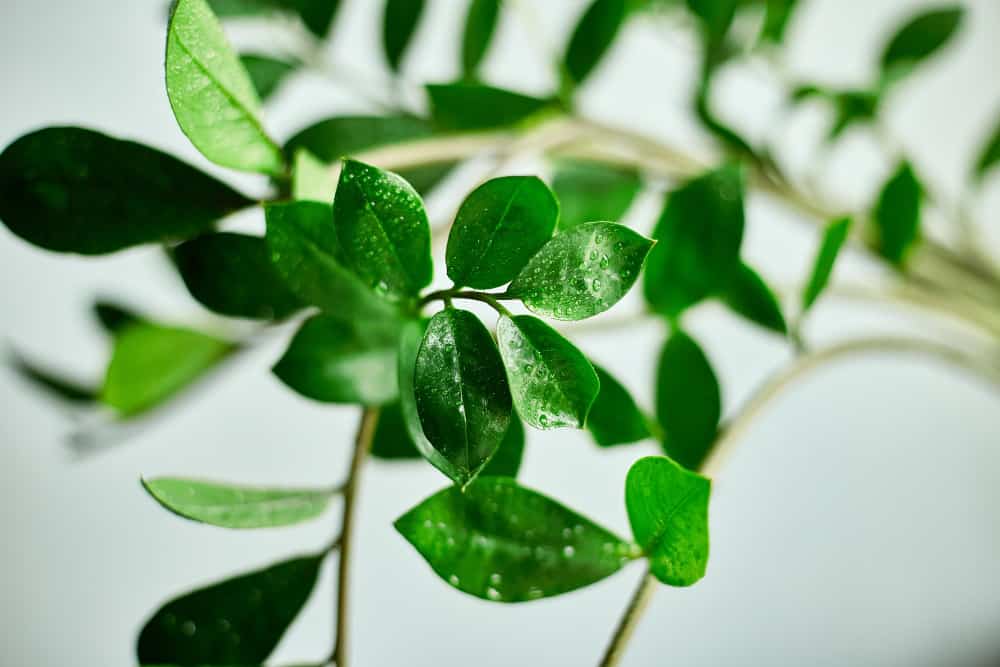
ZZ plants can become rootbound when their roots grow too large for their pot. This can hinder their growth and cause them to stop growing altogether. Repotting the plant in a larger pot can help to solve this problem.
Over time, as the roots of your ZZ plant grow and fill the pot, it can become more challenging for your plant to develop new growth. If you notice roots peeking out of the drainage holes, it’s a sign that your plant may need repotting in a slightly larger container to continue thriving.
If you have had your ZZ plant for a long time and it’s not growing, it may be time to repot it or consider propagating a new plant. Keeping an eye on the plant’s overall health and providing proper care and attention will ensure a healthy and thriving ZZ plant.
Temperature and Humidity:
Humidity is another important factor, as ZZ plants prefer moderate humidity levels. If the air is too dry, the plant may have difficulty growing. Its leaves may become brittle and turn brown at the tips. You can use a humidifier to maintain the humidity level.
Proper air circulation is crucial for the optimal growth of ZZ plants. When the air surrounding the plant remains still, it creates a breeding ground for mold and mildew, harming the plant’s health. Avoid potential damage to your ZZ plant by ensuring sufficient air movement around it.
Lack of Nutrients:
ZZ plants are low-maintenance and do not require fertilizing regularly. However, requires some nutrients to flourish if you observe that your ZZ plant is not growing as fast as it should. It might indicate a nutritional shortage.
Adding high-quality fertilizer to the soil can provide the necessary nutrients and help your ZZ plant flourish. Give it a try and watch your ZZ plant thrive with a healthy dose of fertilizer. low-maintenance
Read More:- How to prune a ZZ Plant
How Fast Do ZZ Plants Normally Grow?
ZZ plants are known for their slow growth. These plants may go dormant during winter but still thrive with proper care and attention. New shoots can grow up to 6-12 inches (15-30 cm) monthly.
They can reach up to 5 feet tall with ideal growing conditions, boasting 6-8 new stems in a single growing season.
These plants thrive during the early spring and summer. But slow their growth as the year progresses, with little to no growth in the winter. If you notice new shoots on your ZZ plant, it’s a good sign that it’s happy with its current care. But, if you haven’t noticed any growth for a time.
ZZ plants develop from underground rhizomes, which are modified stems that grow under the soil. This rhizome produces new stems and roots that spread slowly over time.
Can You Save a ZZ Plant That is Not Growing?
If your ZZ plant is not growing, there are several potential causes that you should consider. Overwatering, poor lighting, and inadequate nutrients are all common issues that can lead to stunted growth in ZZ plants. But, there is hope for your plant with the right approach.
It is possible to save a ZZ plant that is not growing by identifying and addressing the underlying issue. Adjusting watering, fertilizer, or container size are common solutions.
It’s important to inspect your ZZ plant regularly. With proper care and attention, your ZZ plant can thrive and grow into a beautiful addition to your indoor garden.
How do you encourage ZZ growth?
To encourage ZZ growth, you should ensure the plant is placed in a bright, indirect light and avoid overwatering. ZZ plants prefer to dry out between waterings, so allow the top inch of the soil to dry before watering again.
Providing adequate nutrients through regular fertilization and repotting in fresh soil can also promote growth. Additionally, pruning yellow leaf or brown leaves and new stem growth can redirect the plant’s energy toward healthy foliage.
Finally, keeping the plant in a warm, humid environment can also encourage growth.
Are ZZ Plants Easy To Grow?
ZZ plants are generally considered easy to grow and care for, making them a great choice for beginner indoor gardeners. They are known for tolerating low light conditions and can go without water for extended periods.
Additionally, ZZ plants resist pests and diseases, making them a low-maintenance option. Your ZZ plant can thrive and add natural beauty to your indoor space with proper care.
Read More:- 7 Best Moss Pole For Monstera: A Comprehensive Guide
How do you make a ZZ plant bushier?
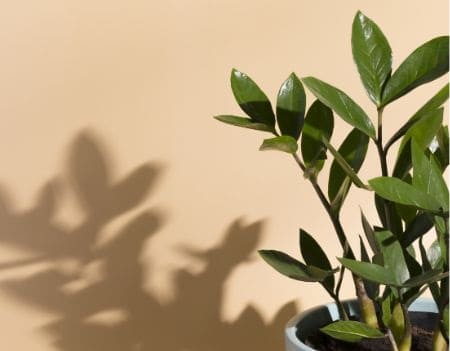
To make your ZZ plant bushier, you can encourage branching by pruning the stems. Simply use sharp, clean scissors to make a small cut just above a leaf node on the stem.
Additionally, you can promote business by providing ample light and ensuring the plant is not overcrowded in its pot.
As the ZZ plant grows and fills out, it will naturally become more dense and lush.
You can help your ZZ plant reach its full potential as a beautiful, thriving houseplant with a little patience and attention.
Is my ZZ plant dormant?
Your ZZ plant may be dormant. If it shows no signs of new growth or if the leaves have turned yellow or brown. But confirming that the plant gets enough water and light is also important.
If you’re unsure if your plant is dormant, you can gently scrape the soil’s surface to check for new root growth. The plant is likely dormant if you don’t see any new roots.
How Much Time Does It Take A ZZ Plant To Grow?
ZZ plants are known for their slow growth. It can take several years to reach their full-size potential. On average, a ZZ plant can grow up to 2-3 feet in height and width over 3-5 years.
But, Its growth rate depends on various factors, such as the plant’s age, health, growing conditions, and care.
New shoots can grow up to 6-12 inches (15-30 cm) monthly in ideal growing conditions. Winter dormancy may slow its growth rate. ZZ plants may grow year-round with sufficient care.
What Size Are ZZ Plants?
| Plant Size | Height | Spread |
|---|---|---|
| Small ZZ Plant | 1-2 feet | 1-2 feet |
| Medium ZZ Plant | 2-3 feet | 2-3 feet |
| Large ZZ Plant | 3-4 feet | 3-4 feet |
| Extra-Large ZZ Plant | 4-5 feet | 4-5 feet |
Why hasn’t my raven ZZ plant grown?
The Raven ZZ plant prefers bright, indirect light, so if it’s not getting enough sunlight, it may not grow as much as it could. Overwatering or underwatering can both stunt plant growth.
Make sure the soil is moist. But not soggy, and allow the top inch of soil to dry out before watering again. A balanced fertilizer can give your plant the nutrients it needs to grow healthy and strong. With proper caring, the Raven ZZ plant should be thriving quickly.
Read More:- 10 Signs My ZZ Plant Dying and How to Fix It
Conclusion
ZZ plants are generally easy to care for and thrive in various conditions. However, several factors can cause stunted growth or yellowing leaves, such as too much or too little light, excess water, or even dormancy during winter.
Proper care is essential, including watering only when the soil is dry and providing bright, indirect light. Additionally, ZZ plants are native to Africa and have adapted to low light conditions, which means too much light can damage their foliage.
I hope you will get all the information you need to understand why is My ZZ Plant not Growing and how to take the necessary steps to promote healthy growth.
Source:- https://www.sfgate.com/homeandgarden/article/ZZ-plant-is-just-so-E-Z-to-grow-3206231.php

